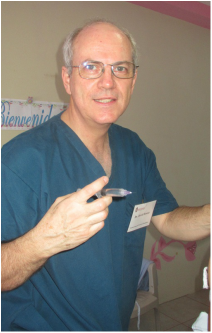|
The University of BC regularly sends out articles by physicians who have found some aspect of medicine has changed the way they practice. I have been meaning to send them my views on the subject and here they are! Thank you to the many patients over the years who have taught me so much about the treatment of pain.
Most physicians like to see evidence of any medical therapy before they embrace or promote it. This is the world of research, which is often not clear cut but at least gives us guidance about what works and what doesn't. Recently we met up with a colleague in BC who is studying the effect of prolotherapy for TMJ or temporomandibular joint syndrome, aka painful jaw. The study is on-going and won't be published for at least a year, but the results thus far are very promising. Most of the patients who were in the non-prolotherapy arm of the study opted to have prolotherapy after their involvement in the study was complete, as they hadn't benefited from the "blinded saline" injection to the same extent as the "blinded dextrose" group. This shows that the proliferative effect of concentrated dextrose into damaged joints is effective, leading to healing and of course less pain - our goal! We have updated the research section of the website, and for your interest and information you can look at these studies near the top of the Links page. Some of the researchers are Jack Taunton, well-known Vancouver sports injury clinic physician, Dean Reeves, "father" of prolotherapy research collation, and David Rabago (and the late Jeff Patterson) of the University of Wisconsin, home of the Hackett Hemwall Patterson Foundation whose teaching of prolotherapy is first class. We have met several of the researchers in the world of prolotherapy and they are enthusiastic about this simple, elegant and effective treatment.
In March 2015 David and I attended a workshop in Vancouver on this muscle testing technique. David Weinstock has found that musculoskeletal pain is often related to muscles being "out of sync" with each other, and he has developed a muscle testing system that helps to identify specific problems, and then has a method to "reboot" the system with a specific time-frame of opportunity for these muscles to learn how to function correctly. The brain (the motor control centre) learns new patterns and often the pain is diminished or goes away.
In March 2015, David and I travelled to Honduras, to the village of Tela, to spend 2 weeks at a medical mission for people with chronic pain. We gave prolotherapy injections to many needy and willing recipients. The people of Honduras are so gracious: first the support team to run these clinics is second to none, and the patients who have so little (and line up for long hours and often travel many miles to come) are so grateful for anything we can do to help relieve their pain. We treated many people with arthritis, injuries, and poorly healing conditions and also benefited ourselves by being surrounded by other fantastic volunteering physicians, including a first rate teaching team. We are all better injectors as a result of these experiences. We salute the Hackett Hemwall Foundation who has been running humanitarian relief work in Honduras (prolotherapy, vein clinics and an ear, nose and throat team) for many, many years. We had the privilege of working under Dr Carl Osborn from Oregon, who celebrated his 20th year of this volunteer work. He is an excellent teacher! (see photo below - Carl is in the brown scrub top below). OK, so we had a bit of time to relax too...
 Sometimes we recommend the use of topical Mannitol cream at home after you have had a treatment at the clinic. Mannitol's chemical structure is a sugar alcohol, and works in the same way dextrose or glycerine injections do: by turning off pain receptors in the body and allowing nerve inflammation to rapidly diminish, so that nerves begin to function and move normally rather than getting tightly caught on openings in the fascia. This means pain goes away. Mannitol was originally discovered in the 14th Century. It comes from the sap of the European Flowering Ash tree, and was named after the Biblical food, manna, which God provided in the wilderness. The beauty of this cream is that it is extremely safe, and can be applied as often as you like, and unlike dextrose cream it is not sticky. However it does need to be compounded at a pharmacy to break up the tiny crystals, and placed into a carrier cream in order to be absorbed. You need to ask us for a prescription for a compounding pharmacy. A colleague is working on an over-the-counter cream which is not yet available. |
AuthorJannice is a family physician with an interest in the treatment of pain. Anything to help the process is added to this blog. Archives
April 2021
Categories
All
|
||||||








 RSS Feed
RSS Feed